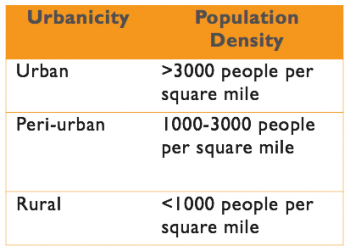Food insecurity is a public health issue that affects 12% of Americans. Individuals living in food insecure households are more likely to suffer from conditions such as undernutrition, obesity and chronic diseases.
Food insecurity has been linked to limited geographic access to food; however, past studies have used limited measures of access which do not fully capture the nuances of community context.
For this study, researchers wanted to better understand the association between urbanicity and food insecurity. To do this, they analyzed 2-1-1 calls made in 2018 in Central Texas and classified these calls as food needs or non-food needs. The final sample consisted of 55,405 calls from 120 zip codes in the 10-county study area. In total, 11% of all calls were regarding food needs.
Researchers defined urbanicity (see table), mapped convenience stores and supermarkets, and used caller zip codes to determine how close callers were to these stores.
Major findings include:
- Urban: Urban residents had higher odds of calling for food needs compared to peri-urban and rural residents. (All callers from urban zip codes resided in a zip code with a supermarket and convenience stores, so comparing by levels of access was not possible).
- Peri-urban: Peri-urban callers had 2.59 greater odds of using 2-1-1 for food-related calls if they only had a supermarket and convenience store in a neighboring zip code compared to their peri-urban counterparts with closer access.
- Rural: Similarly, rural callers had 1.23 greater odds of using 2-1-1 for food-related calls if they only had a supermarket and convenience store in a neighboring zip code compared to their rural counterparts with closer access.
Geographic food access is an meaningful indicator for food need calls and food insecurity among peri-urban and rural communities. This research is important because it highlights the need for development of food insecurity mitigation programs in peri-urban and rural areas.
Janda KM, Salvo Dominguez D, Ranjit N, Hoelscher DM, Price A, van den Berg A. Mapping Food Insecurity-Related 2-1-1 Calls in a 10-County Area of Central Texas by Zip Code: Exploring the Role of Geographic Food Access, Urbanicity and Demographic Indicators. J Community Health. 2020 May 23;. doi: 10.1007/s10900-020-00847-3. [Epub ahead of print] PubMed PMID: 32447543.
